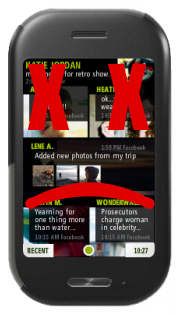Don’t Be Like The Microsoft Kin (Dead On Arrival)
07.08.10 · Sonia Greteman
The world’s most prolific personal computing giant, Microsoft, has completely botched its introduction to the mobile phone market. Only six short weeks following the launch of the Kin, the phone’s development team is being transferred over to work on the Windows Phone 7. Where does this fit in the realm of Microsoft failures? More important, what can we learn from it?
A Brief History of Recent Microsoft Gaffes
We don’t have to dig deep into the days of “Microsoft Bob” (RIP 1995), or bore you with the all-too-well-known history of how the tech giant rang in the new millennium with one of the buggiest operating systems of all time. We needn’t look farther back than three years.
On January 30th, 2007, glossy packages, boasting minimalist design, accented by beautiful flourishes of color and a refreshed logo hit the shelves. It was the release of Windows Vista, an operating system second only to WindowsME in hollowness. The operating system feigned security, asking for you to authorize yourself at every turn, while leaving your computational backend susceptible to the same old enemies. Vista was also a jealous bid to create an interface as beautiful as Apple’s OSX, miserably missing the mark (with clumsy fades, and pointless animations), while simultaneously ruining system performance.
Vista was eventually found to be a software package so foul, that it won 2nd place on TIME Magazine’s May 2009 list: “The 10 Biggest Tech Failures of the Last Decade”. The same article noted that in April of 2009 (almost 4 months after its release) global market share for Window’s Vista was less than 24%, even as its predecessor Windows XP held onto 62%. Despite the fresh promotional materials, the swanky screen effects and the purported increase in security, early reviews, outing the system as a dud, had consumers hesitating to adopt.
Ever hear of the Microsoft Smart Watch? It was a product launched from the company’s Smart Person Objects Technology (or SPOT) initiative in 2004. It was an ugly, bulky wristwatch that used FM radio technology to receive news and weather (something cell phones had just begun to do). Despite the cool factor of living out your Dick Tracy fantasies, and the marketing power of one of the world’s largest corporations, the project died after 5 short years. By this time, people were accessing way more information on their cellphones, so why pay a $9.95 subscription fee for a geeky watch that does little more than confirm that it is in fact cold outside?
Akin to the Kin
The Kin is (was?) a “smartphone” that was designed specifically for connecting with friends via text messages, Facebook, MySpace, Windows Live and Twitter. Friends were front and center in the operating system, relaying to the user photos and recent status updates in an easy to access feed.
The Kin came in two models, the limited Kin One for $49.99 and the “full featured” Kin Two for $99.99. Additionally, to use the Kin you had to pay a mandatory $30 service fee billed monthly. Both versions were launched with an aggressive marketing campaign targeting teens to 29 year olds, with indie hipster imagery pumped through a litany of social media channels. A recent Advertising Age article reports that agencytwofifteen, the marketing firm behind the “hip” campaign, had hyper-targeted the message based on feedback from over 50,000 consumers between the ages of 20-29.
So on May 13, 2010 the Kin was released. It was cheap, targeted at a specific audience with arguably effective tone. What was missing?
The Kin Was Half A Smartphone
Sure you could connect with your friends, but only on the Kin’s terms. While Facebook, MySpace, Windows Live and Twitter were all native to the phone, the user couldn’t download any apps. For the Twitter client included, there was no way to share photos or videos. Kin didn’t have any GPS capabilities. The device didn’t even have a calendar for scheduling appointments, a feature that has been ubiquitous since the dawn of PDA time.
For a small increase in cost, why wouldn’t the consumer get a more powerful, full featured smart phone with the world’s developer community a “tap” away?
What Microsoft Teaches Businesses, Time and Time Again
You don’t need to hire a high-powered research group to glean this one nugget of wisdom from Microsoft’s follies: no matter how much you polish a turd, it’s still a turd. Quality of content, thoughtful design, truly filling a need or improving on an existing idea – these fundamental characteristics are what sell a product. Don’t get me wrong, you still need an excellent communication strategy, broadcasting the value of your product (aptly managed by a highly capable firm like Greteman Group), but it all starts with quality and a product geared towards complete consumer satisfaction.
When you start thinking about introducing a new product into the market, consider activating people within your business or bringing on a strategic partner that can help you identify a few key items: what do consumers want, where do they want it, at what price do they want it, and how to get the word out. Even better, this same research team can help you identify similar products introduced to the market. Perhaps even those that completely flopped (and why). I have no doubt that Apple, HTC and other dominant cell phone entities will be visiting this case study of failure (all the while chuckling smugly, I’m sure).
In the meantime, we’ll be sending this open letter to Microsoft, in an effort to let them know they may have forgotten a couple points, thereby killing what could’ve otherwise been a real neat alternative.
RIP Kin (2010). May you be remembered for your “cool-indie-hipster-girl-traveling-across-the-country” commercials and not by your disturbing lack of basic smartphone features.
